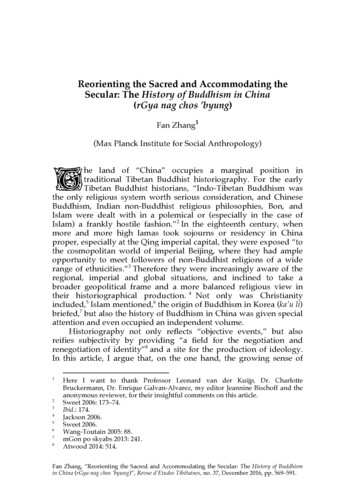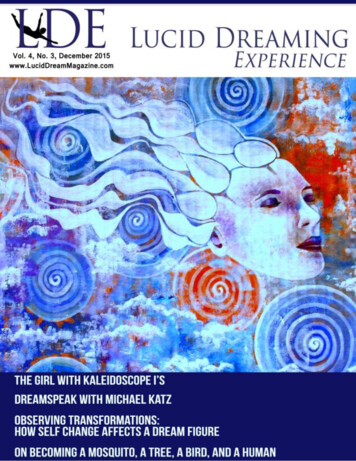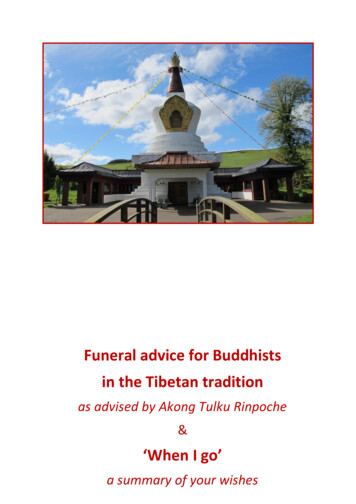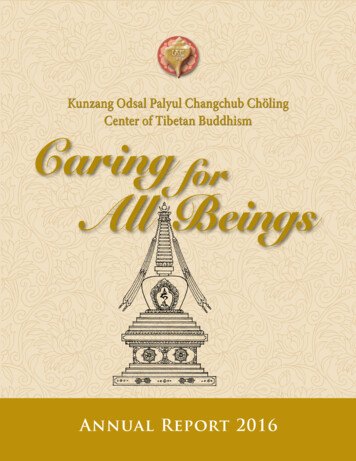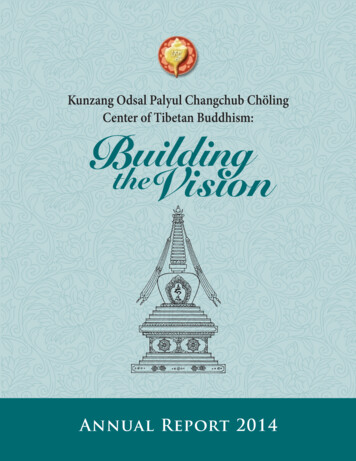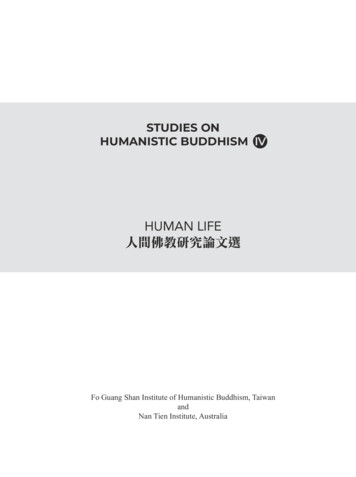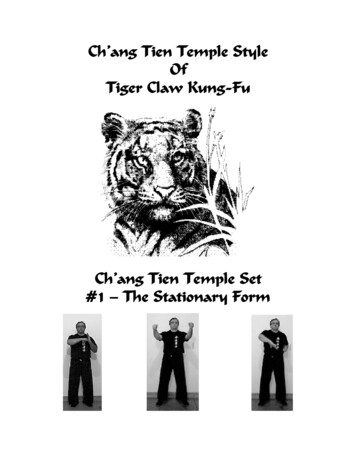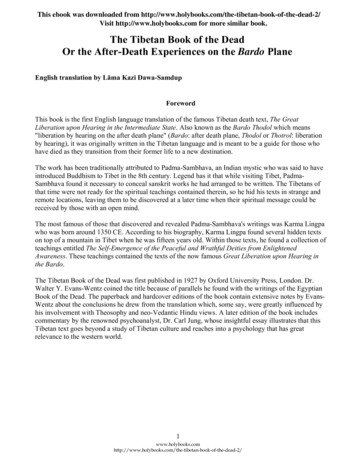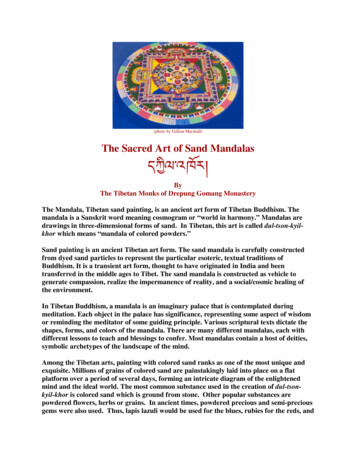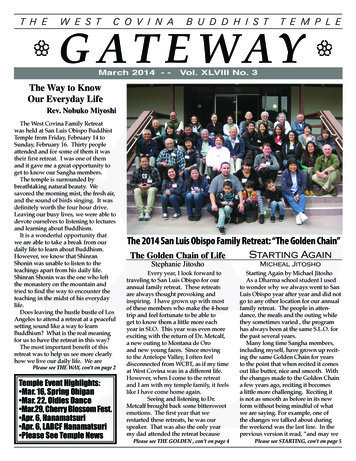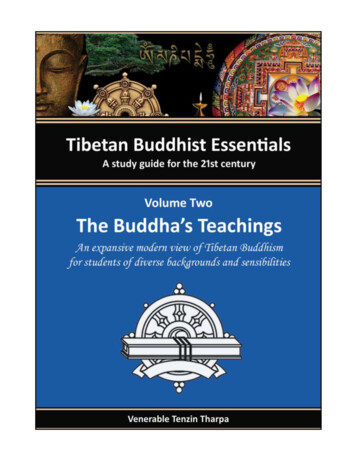
Transcription
----
Tibetan Buddhist Essentials: Volume Two / Venerable Tenzin TharpaTibetan Buddhist EssentialsA Study Guide for the 21st CenturyVenerable Tenzin TharpaVolume 2: The Buddha's TeachingsVolume 1: Introduction, Origin, and AdaptationVolume 2: The Buddha's TeachingsVolume 3: Engaging BuddhismThese texts and other material are available for free download at: hor: Venerable Tenzin TharpaEditors: Nalini Ramesh and Halley HarutaSera Jey Monastic University, Bylakuppe, India1st Edition - 2018Copyright 2018 Venerable Tenzin TharpaAttribution-NonCommercial-NoDerivatives 4.0International (CC BY-NC-ND 4.0)CreativeCommons.orgThis material is free to all. It may be shared, copied, downloaded, and redistributed in anymedium or format, including parts, sections, images, or graphics–although credit to the author(s) must be given. Schools, dharma centers, and teachers are encouraged to share, copy,and upload this material freely to students and to include it as part of their study curriculum.This material may not be altered or built upon without formal permission from its author(s).This material may not be used for commercial purposes, including distributing or selling forprofit. The copyright of this material may not be modified or additional restrictions added.[i]
Tibetan Buddhist Essentials: Volume Two / Venerable Tenzin TharpaAbout the AuthorVenerable Tenzin TharpaA fully ordained American Buddhist monk in the Tibetan Gelug Tradition, Venerable Tharpa is a teacher, author, and philosopher with over two decades in Tibetan Buddhist studies, half of which he has spent in Tibetan Buddhist monasteries in India.Venerable Tharpa took full monastic ordination with His Holiness the Dalai Lama in DharamsalaIndia. Subsequent to ordination, Venerable Tharpa accepted an invitation to be the first Westerner to study at the renowned Gyudmed Tantric Monastic University in South India.Well known for his pragmatic, no-nonsense approach to the teachings, his ability to clarifycomplex philosophical points for all audiences, and his familiarity with all forms of Buddhistthought and non-Buddhist traditions as well, Venerable Tharpa is quickly becoming a valuedteacher for our modern multicultural age. Currently, Venerable Tharpa resides at Sera Je Monastery in Bylakuppe, South ------------Dear reader,Thank you for your interest in this text. I hope it brings to you the clarity and insight that youseek. In my writing, I endeavor to make the Buddha's teachings available to a wide audience,while also striving to convey to the reader the positive, life-affirming joy that permeates theBuddha's teachings, yet is often lost or overlooked in dry translations. For when understoodproperly, every aspect of the Buddha's teachings pertains to freedom and liberation: freedomfrom our daily self-imposed suffering, and liberation from mundane and unsatisfactory existence. In the spirit of the Buddha's vast generosity, all of my work, be it teaching or writing, isalways free. If you enjoy this text and would like to see work of this nature continued, pleaseconsider lending your support.Thanks and prayers,Tenzin TharpaVenerable Tenzin TharpaSera Jey Monastery - 2018Bylakuppe, India[ii]
Tibetan Buddhist Essentials: Volume Two / Venerable Tenzin TharpaTexts by Venerable Tenzin TharpaTibetan Buddhist Essentials1st edition 2018 - Free online textsVolume 1: Introduction, Origin, and AdaptationVolume 2: The Buddha's TeachingsVolume 3: Engaging BuddhismSpoken Tibetan BasicsA Tibetan language primer (for English speakers)1st edition 2013 – A free online textTibetan Conversation Text-1A conversation method text for Tibetan language studies (for English speakers)1st edition 2013 – A free online textDebate Text-1 / Foundations of DebateA method text for dialectic debate in the Tibetan language (for English speakers)1st edition 2011 – A free online textEnglish Conversation Text-1A conversation method text for English language studies (for Tibetan speakers)1st edition 2011 – A free online textEnglish Conversation Text-2A conversation method text for English language studies (for Tibetan speakers)1st edition 2012 – A free online textThese texts and other material are available for free download at: TenzinTharpa.com[iii]
Tibetan Buddhist Essentials: Volume Two / Venerable Tenzin TharpaPraise to ManjushriI bow down to you, O Manjushri. With the brilliance of your wisdom,O compassionate one, illuminate the darkness enclosing my mind.Enlighten my intelligence and wisdom so that I may gain insight intothe Buddha's words and the texts that explain them.Manjushri is the manifestation of the Buddha's wisdom and the deity that represents transcendent insight and discriminating awareness. It is tradition to start Tibetan Buddhist texts withprayers and praise to this eminent bodhisattva whose flaming sword symbolizes blazing enlightened wisdom that cuts through ignorance, afflictions, and delusions. Most Tibetans starttheir day by reciting his mantra. It can be heard at the crack of dawn in every monastery andTibetan community being recited by monks, nuns, and devoted lay people.Mantra of Manjushri: Om ah ra pa tsa na di[iv]
Tibetan Buddhist Essentials: Volume Two / Venerable Tenzin TharpaDedicationI dedicate this text to today’s progressive Buddhist masters,first and foremost my own teacher His Holiness the 14th Dalai Lama.Additionally, I would like to dedicate this text to the monks of Sera Jey Ngari House Group.Sera Jey Ngari Khangtsen, Bylakuppe, South India.Lastly, I dedicate this text to those who inspired this work and continue to inspire me:Venerable Lobsang Dorje, Venerable Tendhar, my big sister Nalini Ramesh, Mary Ann Chang,Linda Noble, the Mowat family, the Aieta family, Alex Hayes, Jewan Kaur, Sammy Squire,Elroy Fernandes, Suzanne Kanatsiz, Kris and Pete Barnes, Thomas Winzeler, AndrewBresnen, Linus Hammarstrand, Rob Miller, and Dave Nagy.[v]
Tibetan Buddhist Essentials: Volume Two / Venerable Tenzin TharpaTable of ContentsPrefaceviiIntroductionx1CHAPTER ONE: The Buddha's first teachingsThe foundation of the Buddhist path - The three higher trainings3The four noble truths4Further understanding suffering8CHAPTER TWO: The Buddha's unique model of reality12Karma13Merit20Dependent origination22Emptiness27The two truths32CHAPTER THREE: The Buddha's teachings on no-self38No-self39What constitutes a person39The five aggregates40Mind and consciousness41The Buddha’s unique presentation of person46CHAPTER FOUR: Death and rebirth59Rebirth60Death and the death process62The twelve links of dependent origination67[vi]
Tibetan Buddhist Essentials: Volume Two / Venerable Tenzin TharpaCHAPTER FIVE: The true nature of reality69The true nature of reality according to Buddhism70Common existential questions72CHAPTER SIX: Enlightenment74Enlightenment and nirvana75Full enlightenment and buddhahood81Buddha pure lands84Buddha bodies85CHAPTER SEVEN: The path to enlightenment89The Mahayana path to buddhahood90The three principle aspects90The four vehicles for traversing the path90Ground, path, and fruition91The two collections92Abandonments along the path93Outline of the Mahayana path to buddhahood93Stages of the path: Grounds and paths95CHAPTER EIGHT: Buddhist cosmology101Buddhist cosmology/mythology102The cosmos according to Buddhist scripture104Beings within Buddhist cosmology109CHAPTER NINE: Benefits and misconceptions of the Buddhist viewBenefits of holding the Buddhist view114115[vii]
Tibetan Buddhist Essentials: Volume Two / Venerable Tenzin TharpaCommon misconceptions about the Buddhist view116Conclusion120APPENDIX121Buddhist symbols, ritual Implements, and paraphernalia122Foundational deities130Glossary of Buddhist terms132Recommended reading172Bibliography176[viii]
Tibetan Buddhist Essentials: Volume Two / Venerable Tenzin TharpaPrefaceIn the winter of 2013, during a teaching at Sera Monastery in South India, His Holiness the 14thDalai Lama expressed the wish for monastics to engage in and share a broader view of Buddhism: a view that celebrates the wealth of Buddhist thought as expressed through its manytraditions; a view that values, and is knowledgeable of, the greater spiritual community atlarge. This text is the culmination of that wish.His Holiness continuously emphasizes that Tibetan Buddhists need to study diligently, be wellinformed, and be grounded in facts, logic, and reason. They need to embrace a broader worldview, cultivate an understanding that includes many disciplines of investigation, and utilize allthe tools at one’s disposal, or in his own words:“We have to be 21st century Buddhists.” The 14th Dalai LamaThe importance of a broad view cannot be overstated. Not only is a broad view a more logicalapproach to study, by including many different sources of information leading to a more comprehensive base of knowledge; a broad view also allows one to contrast and compare, resultingin a more holistic understanding and view which is essential in cultivating reliable conclusions.Moreover, in my own experience, practitioners with a broad view tend to be more humble,open minded, rational, and less dogmatic and sectarian.The inspirations for this text were many. Initially, I was inspired by friends who enjoyed listening to me share my contemporary thoughts on Buddhism and requested that I write a progressive text that could be studied and shared. I agreed for I also believed a modern text sharing the thoughts of today’s progressive masters was indeed needed. Here I define progressivemasters as those who work to demystify Buddhism, ushering it out of its traditional religiouspresentation and into a more rational and practical approach. This style of presentation is onethrough which many believe the Buddha always intended his teachings to be shared. Some ofthese modern progressive masters include: His Holiness the 14th Dalai Lama, Lama ThubtenYeshe, Dzongsar Khyentse Rinpoche, Geshe Tashi Tsering, Geshe Thubten Jinpa, Prof. Jay Garfield, Prof. Jeffery Hopkins, Prof. Richard Gombrich, Jetsunma Tenzin Palmo, Stephen and Martine Batchelor, Alan Wallace, S.N. Goenka, and Jack Kornfield, to name a few.Additionally, I created this text to share with others, while clarifying for myself, theknowledge and experience I have gained from my many years of study in Tibetan monasteriesthroughout India, Nepal and Tibet, including teachings I received from some of today’s greatliving masters, foremost that of my own teacher His Holiness the 14th Dalai Lama. Through myexperience, I have found that within Tibetan monasteries, the style and approach to Buddhist[ix]
Tibetan Buddhist Essentials: Volume Two / Venerable Tenzin Tharpastudy and practice are often different from the styles predominantly presented in the West,with monasteries offering a more rational and practical approach–a fact that a majority ofWesterners are simply not aware of. Westerners are also not aware of the many different stylesand variety of choices available to them when exploring Buddhism–choices that can greatlyshape one’s experience. Finally, in the tradition of many students and scholars before me, thistext serves as my culminating thesis marking the completion of my sutra education at the monastic universities of Sera Jey Monastery and Gyudmed Tantric Monastery in South India. Thistext shares the authentic presentation of Buddhism as taught within Tibetan monasteries anduniversities, assembled into an easily accessible and no-nonsense format. This text was writtenas objectively as possible. However, in the end, it is impossible to keep out one’s bias altogether, for inevitably one chooses or cherry picks the information that they favor, believing it to bethe most accurate and relevant to share–the information they believe best captures the essence of the Buddha’s teachings.I wrote this text with three types of readers in mind: the first, everyday people like many ofmy friends back home–hard working people that are simply too busy trying to sustain their livesto have the time for in-depth study. My intention was to undergo formal study and then tocompile what I have learned so they too can taste the path of freedom for themselves. Secondly, this text was created for Buddhist teachers looking for a modern authentic presentation ofTibetan Buddhism that can serve as a basic teaching outline to be further expounded upon.Thirdly, this text is intended for those who wonder if their own critical and rational mindsetmakes their beliefs incompatible with Buddhism. For I have come to find a growing group that Ibelieve is unrepresented within the Buddhist community. People who are drawn to the practical wisdom of the Buddha, but often feel disaffected by the more religious and/or culturalpresentations found in many of the Western Buddhist groups they have investigated. Peoplewho seek the Buddha's sensible and practical methods for improving and finding fulfillment andpurpose in their lives, but may not know where to begin. For all those who can identify withthis this text is for you.[x]
Tibetan Buddhist Essentials: Volume Two / Venerable Tenzin TharpaIntroduction to This TextAs the cover of this book states, this text presents an expansive and contemporary worldviewof Tibetan Buddhism for readers of diverse backgrounds, ideologies, and beliefs. It serves as avoice for today’s progressive Buddhist masters, offering a clear, concise, and transparentpresentation of Buddhism, and Tibetan Buddhism in particular. This text highlights the work ofmodern Tibetan and Western Buddhist scholars alike and their skillful efforts in transmitting theauthentic Buddhist teachings to a new generation of students. The material in this text, onceunderstood, forms a basic foundational education in Tibetan Buddhism. Once one is comfortable with the topics contained in this text, they may consider themselves as having a reasonableworking knowledge of the subject.This text is divided into three volumes and is meant to be studied in sequential order.Volume one, Introduction, Origin, and Adaptation, begins with a broad view of the origin andvarious adaptations of Buddhism, while also introducing the reader to essential elements thatare shared by all Buddhist traditions, elements that must be understood in order to comprehend the later volumes. The second volume, The Buddha's Teachings, moves onto a more formal presentation of the Buddha’s actual teachings. The third volume, Engaging Buddhism, outlines what is involved in engaging with the Buddhist path, including a detailed account of Buddhist study and practice. Customarily texts that introduce Buddhism do so from a scripturaland/or religious viewpoint, whereas this text, while still offering the traditional scripturalpresentation, also offers the historical as well as modern scholastic views. The intention behindthis was to present a comprehensive text that favors an objective and open presentation, whileat the same time pointing out beliefs that are obviously dogmatic, unlikely, and/or mere superstition. I will be sharing the presentation of Buddhism from my own chosen path of study—thatof the Gelug School of Tibetan Buddhism as currently taught by His Holiness the 14 th Dalai Lama. This is done not out of partiality, but practicality, allowing me to write from my personalexperience and field of expertise. Comparisons are made between traditions when necessary,but this being an introductory text, information is kept as clear and straightforward as possible.The Buddhist philosophical view presented in this text is the view of the Middle Way Consequence School within the Mahayana tradition (Skt. prasangika madhyamika; Tib. uma talgyur).The Middle Way Consequence view is shared by all schools of Tibetan Buddhism, a view originating from the legendary Indian University of Nalanda in Bihar, India (c. 500 BCE - 1197 CE).This text then follows the further interpretations of the Middle Way Consequence School asserted by the renowned Tibetan master Lama Je Tsongkhapa, founder of the Gelug School ofTibetan Buddhism. Traditionally, Buddhist study as taught within monasteries is a long and tedious undertaking, with monastics often spending half of their education on preliminary andfoundational studies before ever reaching the final philosophical view. Because of this, monks[xi]
Tibetan Buddhist Essentials: Volume Two / Venerable Tenzin Tharpawho leave the monastery prematurely, although having studied for years, may know very littleabout the Buddha’s actual teachings. For this reason, this text, although being introductory,shares the full and final view of Lama Tsongkhapa and the Gelug school.Some believe it is misguided to try to assert a single definitive final view, for to this day theBuddhist view continues to be debated and pondered, with many prominent masters holdingdifferent views. However, for the sake of creating a clear and comprehensive basic presentation, I believe there is more than enough agreed upon material to posit a standard view. Additionally, because the final view is a mixture of sutra and tantra teachings, positing it for the novice was challenging. Therefore this text will primarily follow the Gelug sutra presentation, whileincorporating aspects of the tantric teachings when deemed necessary in order to present anaccurate and complete picture of Tibetan Buddhism and the Tibetan Buddhist view.Technical Considerations Within This TextProblems with Language when sharing BuddhismLanguage is often a significant obstacle when sharing any philosophical and/or ideological system, with terms having diverse meanings within the various disciplines and schools of thought.Terms are commonly borrowed, reused, and reabsorbed in ever-increasingly abstract and complex ways. One example is the Tibetan term marigpa, translated as ignorance, a term that isused extensively within Buddhist texts. However, in the West, the term ignorance is oftenviewed as derogatory–noting a lack of education or stupidity, whereas in Buddhism, ignoranceis understood as a foundational existential confusion pertaining to the nature of reality. Buddhism’s textual migration into the West first began in the early nineteenth century through often poor translations from Pali, Sanskrit, and Chinese. This work was done chiefly by religiousscholars, many of whom, because they were translating what they believed to be texts thatwere purely religious in nature, used religious terms from their own Judeo-Christian backgrounds. In the early 1970s, the Tibetan Buddhist master Chogyam Trungpa began teachingsand translating in the West. Besides being one of the first lamas to bring Tibetan Buddhism tothe West, he was also one of the first to begin using psychological terminology when translatingBuddhism–a discipline in which Buddhist thought is much more at home. Later, Western Buddhist scholars would begin to also incorporate Western philosophical and scientific terminologyas well.Translation used within this textIn order to promote the standardization of Buddhist terminology in the West, this text favorsthe terminological presentation of Jeffrey Hopkins whenever possible. Jeffrey Hopkins is anAmerican Tibetologist, and Emeritus of Tibetan and Buddhist Studies at the University of Virgin[xii]
Tibetan Buddhist Essentials: Volume Two / Venerable Tenzin Tharpaia, where he has taught for more than three decades. He has authored more than twenty-fivebooks on Tibetan Buddhism and from 1979 to 1989, he was the Dalai Lama's chief interpreter.A pioneer in the study and translation of Tibetan Buddhism, he is considered by many to possess the clearest and most valid views on the subject.Problems with positing Buddhist and Indian historyCurrently there is great debate pertaining to the Buddhist/pre-Buddhist era in Indian history.This time, roughly 3,500 BCE to 250 BCE, is still currently being uncovered and is simply not asclear as many would like it to be. One example of this is that traditionally historians place theBuddha life between 563 BCE - 483 BCE. However, these dates are currently in question withsome proposing the Buddha may have lived up to three-hundred years earlier than previouslybelieved, while others assert he may have lived one-hundred years later. This is an excellentexample of the delicateness of the posited history of this era and the ongoing investigation anddebate currently underway. Another example of the vagueness of early Buddhist history is thefact that most of the historical information and written records of Indian Buddhism comes frompersonal journals of Chinese pilgrims who made extensive and detailed accounts of their travelsthroughout India starting in the 5th century CE. Sadly, the Buddhist scriptures themselves aresimply unreliable as evidence for historical records or dates. India was and has always been aland in which its many cultural groups influenced each other openly and freely. Therefore tryingto posit a definitive history and/or definitive dates of events is unrealistic at this point. Indianhistory, much like the way India views its cultures–as the merging of great rivers, is a historythat has continually flowed and changed, while absorbing and exporting cultures, philosophies,and ideas. This text does not attempt to be an authority on Indian history or the origins of Indian religious or philosophical thought but simply attempts to share the most currently acceptedtheories and timelines of Buddhism within Indian history.Positing the Historical BuddhaMany popular Buddhist texts fail to posit the Buddha in his proper historical context, that of anIndian guru who lived and taught in Northeast India during the 6 th century BCE. The Buddha began his legendary journey by sharing his experiences that arose from his personal practice tothose who would listen. In this way he developed a teaching method and tradition that wouldgrow to profoundly change the world in unprecedented ways. Furthermore, Buddhist textsrarely mention the fact that most of the core beliefs that Buddhists hold today were in placelong before the Buddha's arrival, beliefs shared by most Indian traditions to this day.Modern innovation in interpretationNever before has there been so many tools at our disposal with which to examine Buddhism.Today we have MRI and EEG imaging that can observe the brains of active meditators, and aca[xiii]
Tibetan Buddhist Essentials: Volume Two / Venerable Tenzin Tharpademically, we have scholars that can compare and contrast the various Buddhist scriptures, allwithin their respective languages (Pali, Sanskrit, Tibetan, Chinese, and Japanese), a development in Buddhist scholarship previously unheard of. But one of the greatest tools at our disposal that past scholars lacked, is history. For although Buddhist history has existed, each traditiononly preserved its own isolated account. It is only recently that all of these various records ofBuddhist history have become readily accessible for comparison. Additionally, and possiblymore significantly, we now possess a broad overview of the history of successes and failures ofthe various Buddhist traditions, their philosophies, doctrines, practices, innovations, work atintegration, propagation, sustainability, etc., allowing us to determine what have been proventruly beneficial and also what have been obstacles to the actualization, propagation, andpreservation of the Buddha's teachings. This means that today we are capable of a level of investigation that is far greater than ever before. This should not be seen as a threat to traditionalBuddhism, but simply as the latest development in a long tradition of continuous innovationthat began over twenty-six-hundred years ago. By continuing to investigate and substantiateboth the validity of Buddhism’s claims as well as potential benefits of its practices, we aid Buddhism in two ways: firstly, by clearly demonstrating both the universality and legitimacy of theBuddhist teachings and showing Buddhism to be a safe and effective path. And secondly, byproviding reassurance to those currently traversing the Buddhist path that their efforts are indeed advantageous.Accuracy regarding this textAccuracy is of paramount importance when authoring any Buddhist text, and for myself, theresponsibility of such an undertaking was quite daunting. This text took over two years to write,but took an additional two year to edit and proof the vast array of content compiled. Of coursestudying in South India at Sera and Gyudmed Monasteries was of obvious benefit, giving meaccess to countless Tibetan and Western masters of the highest caliber. Additionally, my location also gave me access to masters of other traditions as well, both Buddhist and non-Buddhistalike. Although beginning as a solo work, during the final editing process, this text became a collaborative effort by the many scholars at both Sera and Gyudmed Monasteries.Other technical considerationsWith the intention to try to present a fairly concise introductory text for the novice, technicalelaboration, lengthy scriptural quotes, various counter interpretations, and additional noteshave been omitted due to space concerns.The term Westerner used for non-Tibetan or non-HimalayanWithin this text when referring to non-Tibetans or non-Tibetan culture, or more appropriatelynon-Himalayans and non-Himalayan culture–for the Tibetan culture pervades most Himalayan[xiv]
Tibetan Buddhist Essentials: Volume Two / Venerable Tenzin Tharpacountries—I’ve chosen to use the terms Westerners and Western culture. This was done simplyfor the lack of a better term. This Western-Eastern terminological division is of course commonand longstanding in many disciplines, including philosophy, religion, medicine, sociology, academia, literature, etc. This dichotomy is cultural and technological, not geographical, and it ispurely conceptual, lacking any fixed borders. In this context, the term Western can be seen asakin to the terms modern or contemporary. I understand this can be seen as being insensitive tomy Asian friends who may feel left out by the terms, including monks from my monastery,many of whom are from the various neighboring Himalayan countries outside of Tibet, who Iclassify here as Tibetans. I apologize to anyone I may offend through this manner of classification. With that said, although I intended this text to speak to a world audience, I often unconsciously find myself slipping into dialogue with the Western audience, an occurrence I did notintend.In conclusionMy hope is that this text may inspire and bring a freshness to the Buddha’s teachings for a newgeneration of students. Those who are bright, confident, and discerning, who put reason beforeblind faith, who use logic and critical investigation to explore the world of ideas around them,those who are not afraid to ask the tough questions.[xv]
Tibetan Buddhist Essentials: Volume Two / Venerable Tenzin TharpaAcknowledgmentsSpecial thanks to:Prof. Jay Garfield and Prof. Jeffery Hopkins for their inspiration and support.My wonderful editors: Nalini Ramesh and Halley Haruta.I would like to thank the following people for their help in validating the information in thistext. It is due to their efforts that this text may be recommended confidently and freely as a reliable and accurate source of information for students wishing to develop a basic understandingof authentic Tibetan Buddhism, as well as a credible outline for teachers to expound upon within their own teachings and classrooms.From Sera Jey Monastery, Bylakuppe, South India (Gelug School of Tibetan Buddhism)Geshe Ngawang Sangye, Geshe Tenzin Namdak, Venerable Tenzin Gache, Venerable TenzinLegtsok, Venerable Tenzin Thinly, Venerable Jampa Topgyal, Venerable Lobsang Samphel, Venerable Ngawang Khunphel, Venerable Tenzin Namjong, and Venerable Lobsang Lekshe.From Maha Bodhi Society Bangalore, South India (Theravada Tradition)Venerable Buddhadatta and Venerable Saranananda.From Mysore University, South IndiaDr. H.I. Shekara - Hindu studies and Indian philosophy/historyDr. Abhijeet Jain - Jain studies and Indian philosophy/historyAdditionallyNgarampa Sangye Tsultrim - Gyudmed Tantric Monastery, South India (Gelug School)Khenpo Sonam Tsewang - Namdroling Monastery, South India (Nyingma School)Khenpo Thupten Phuntsok - Tsechen Dongag Choeling Monastery, South India, (Sakya School)Muni Shri Raivat Bhushan - Sri Suvidhinath Rajendrasuri Jain temple, Mysore, South India.Any mistakes in this text are solely my own and not that of my wonderful teachers.May all beings benefit from any merit gained from this work.[xvi]
Tibetan Buddhist Essentials: Volume Two / Venerable Tenzin TharpaTibetan Buddhist EssentialsVolume Two: The Buddha's TeachingsChapter One: The Buddha's First Teachings[1]
Tibetan Buddhist Essentials: Volume Two / Venerable Tenzin TharpaThe presentation of the Buddha’s teachings within this volumeAs mentioned earlier, there are many unique interpretations and presentations of the Buddha’steachings asserted by the different Buddhist traditions; be it the grounded Theravada, the universal Mahayana, or the mystical Vajrayana. However, there is no standard view of the Buddha’s teachings in which everyone agrees. This includes the four schools of Tibetan Buddhism,in which each school asserts their own unique view. To this day, many important topics are stillbeing actively debated, with scholars, even within the same monasteries, holding subtle different views. With that said, for the sake of simplicity for the novice, this text endeavors to posit aconcise standardized view of the Buddha’s teachings according to the interpretation of theMiddle Way Consequence School of Tibetan Buddhism (Skt. pra
Tibetan Buddhist Essentials 1st edition 2018 - Free online texts Volume 1: Introduction, Origin, and Adaptation Volume 2: The Buddha's Teachings Volume 3: Engaging Buddhism Spoken Tibetan Basics A Tibetan language primer (for English speakers) 1st edition 2013 – A free
